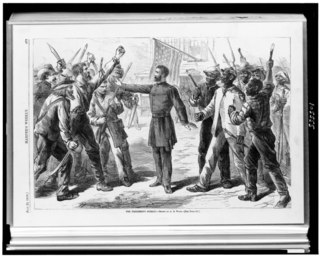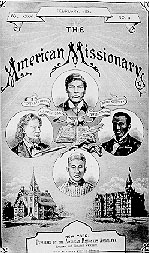
The Reconstruction era was a period in American history following the American Civil War (1861–1865) and lasting until approximately the Compromise of 1877. Its main goals were to rebuild the nation after the war, reintegrate the former Confederate states, and address the social, political, and economic impacts of slavery.

United States Colored Troops (USCT) were Union Army regiments during the American Civil War that primarily comprised African Americans, with soldiers from other ethnic groups also serving in USCT units. Established in response to a demand for more units from Union Army commanders, by the end of the war in 1865 USCT regiments, which numbered 175 in total, constituted about one-tenth of the manpower of the army. Approximately 20% of USCT soldiers were killed in action or died of disease and other causes, a rate about 35% higher than that of white Union troops. Numerous USCT soldiers fought with distinction, with 16 receiving the Medal of Honor. The USCT regiments were precursors to the Buffalo Soldier units which fought in the American Indian Wars.

The Bureau of Refugees, Freedmen, and Abandoned Lands, usually referred to as simply the Freedmen's Bureau, was an agency of early Reconstruction, assisting freedmen in the South. It was established on March 3, 1865, and operated briefly as a U.S. government agency, from 1865 to 1872, after the American Civil War, to direct "provisions, clothing, and fuel...for the immediate and temporary shelter and supply of destitute and suffering refugees and freedmen and their wives and children".

Forty acres and a mule was part of Special Field Orders No. 15, a wartime order proclaimed by Union General William Tecumseh Sherman on January 16, 1865, during the American Civil War, to allot land to some freed families, in plots of land no larger than 40 acres (16 ha). Sherman later ordered the army to lend mules for the agrarian reform effort. The field orders followed a series of conversations between Secretary of War Edwin M. Stanton and Radical Republican abolitionists Charles Sumner and Thaddeus Stevens following disruptions to the institution of slavery provoked by the American Civil War. Many freed people believed, after being told by various political figures, that they had a right to own the land they had been forced to work as slaves and were eager to control their own property. Freed people widely expected to legally claim 40 acres of land. However, Abraham Lincoln's successor as president, Andrew Johnson, tried to reverse the intent of Sherman's wartime Order No. 15 and similar provisions included in the second Freedmen's Bureau bills.

Samuel Chapman Armstrong was an American soldier and general during the American Civil War who later became an educator, particularly of non-whites. The son of missionaries in Hawaii, he rose through the Union Army during the American Civil War to become a general, leading units of African American soldiers. He became best known as an educator, founding and becoming the first principal of the normal school for African-American and later Native American pupils in Virginia which later became Hampton University. He also founded the university's museum, the Hampton University Museum, which is the oldest African-American museum in the country, and the oldest museum in Virginia.

The American Missionary Association (AMA) was a Protestant-based abolitionist group founded on September 3, 1846 in Albany, New York. The main purpose of the organization was abolition of slavery, education of African Americans, promotion of racial equality, and spreading Christian values. Its members and leaders were of both races; The Association was chiefly sponsored by the Congregationalist churches in New England. The main goals were to abolish slavery, provide education to African Americans, and promote racial equality for free Blacks. The AMA played a significant role in several key historical events and movements, including the Civil War, Reconstruction, and the Civil Rights Movement.

John Gray Foster was an American soldier. A career military officer in the United States Army and a Union general during the American Civil War, he served in North and South Carolina during the war. A postbellum expert in underwater demolition, he wrote a treatise on the subject in 1869. He continued with the Army after the war, using his expertise as assistant to the Chief Engineer in Washington, DC and at a post on Lake Erie.

Mitchelville was a town built during the American Civil War for formerly enslaved people, located on what is now Hilton Head Island, South Carolina. It was named for one of the local Union Army generals, Ormsby M. Mitchel. The town was a population center for the enterprise known as the Port Royal Experiment.

The Port Royal Experiment was a program begun during the American Civil War in which former slaves successfully worked on the land abandoned by planters. In 1861 the Union captured the Sea Islands off the coast of South Carolina and their main harbor, Port Royal. The white residents fled, leaving behind 10,000 black slaves. Several private Northern charity organizations stepped in to help the former slaves become self-sufficient. The result was a model of what Reconstruction could have been. The African Americans demonstrated their ability to work the land efficiently and live independently of white control. They assigned themselves daily tasks for cotton growing and spent their extra time cultivating their own crops, fishing and hunting. By selling their surplus crops, the locals acquired small amounts of property.
The Grand Contraband Camp was located in Elizabeth City County, Virginia, on the Virginia Peninsula near Fort Monroe, during and immediately after the American Civil War. The area was a refuge for escaped slaves who the Union forces refused to return to their former Confederate masters, by defining them as "contraband of war". The Grand Contraband Camp was the first self-contained black community in the United States and occupied the area of the downtown section of the present-day independent city of Hampton, Virginia.

This is a selected bibliography of the main scholarly books and articles of Reconstruction, the period after the American Civil War, 1863–1877.

African Americans, including former slaves, served in the American Civil War. The 186,097 black men who joined the Union Army included 7,122 officers and 178,975 enlisted soldiers. Approximately 20,000 black sailors served in the Union Navy and formed a large percentage of many ships' crews. Later in the war, many regiments were recruited and organized as the United States Colored Troops, which reinforced the Northern forces substantially during the conflict's last two years. Both Northern Free Negro and Southern runaway slaves joined the fight. Throughout the course of the war, black soldiers served in forty major battles and hundreds of more minor skirmishes; sixteen African Americans received the Medal of Honor.
Black schools, also referred to as "Negro schools" and "colored schools", were racially segregated schools in the United States that originated in the Reconstruction era after the American Civil War. They were created in Southern states under biracial Republican governments as free public schools for the formerly enslaved. All their students were blacks. After 1877, conservative whites took control across the South. They continued the black schools, but at a much lower funding rate than white schools.
The civil rights movement (1865–1896) aimed to eliminate racial discrimination against African Americans, improve their educational and employment opportunities, and establish their electoral power, just after the abolition of slavery in the United States. The period from 1865 to 1895 saw a tremendous change in the fortunes of the black community following the elimination of slavery in the South.

Henry Martin Tupper was an American Baptist minister who founded Shaw University in Raleigh, North Carolina. Beginning with bible and literacy classes in December 1865, it was the second university established for African Americans following the end of the civil war, and the second oldest historically black college and university (HBCU) in the Southern United States, as well as one of the oldest co-educational universities in the country. When the institute moved into a new building in 1871, it was renamed as Shaw Collegiate Institute in honor of a major donor. Tupper served as the University's first president from its founding until his death in 1893.
The Freedmen's Colony of Roanoke Island, also known as the Roanoke Island Freedmen's Colony, or "Freedman's Colony", was founded in 1863 during the Civil War after Union Major General John G. Foster, Commander of the 18th Army Corps, captured the Confederate fortifications on Roanoke Island off North Carolina in 1862. He classified the slaves living there as "contraband", following the precedent of General Benjamin Butler at Fort Monroe in 1861, and did not return them to Confederate slaveholders. In 1863, by the Emancipation Proclamation, all slaves in Union-occupied territories were freed.
African Americans are the second largest census "race" category in the state of Tennessee after whites, making up 17% of the state's population in 2010. African Americans arrived in the region prior to statehood. They lived both as slaves and as free citizens with restricted rights up to the Civil War.
The Union Academy was a school founded with the aid of the Freedmen's Bureau in Gainesville, Florida in 1867. It was the first school for African Americans in Gainesville and Alachua County, and provided a free quality education to African Americans when public schools in Alachua County were struggling. The Union Academy was eventually absorbed into the county school system, and remained in operation until 1923.

Freedmen's Schools were educational institutions created soon after the abolition of slavery in the United States to educate freedmen. Due to the remaining opposition to equality between blacks and whites, it was difficult for the formerly enslaved to receive a proper education, among a myriad of other things. Schools were made especially for blacks but were open to anyone regardless of race. These schools were far from perfect; however, they did give African Americans hope and opportunity for their future.
History of education in the Southern United States covers the institutions, ideas and leaders of schools and education in the Southern states from colonial times to about the year 2000. It covers all the states and the main gender, racial and ethnic groups.












